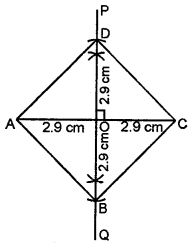ML Aggarwal Class 8 Solutions for ICSE Maths Chapter 14 Constructions of Quadrilaterals Check Your Progress
Question 1.
Construct a quadrilateral ABCD such that AB = 4·5 cm, BC = 4 cm, CD = 3·9 cm, AD = 3·2 cm and ∠B = 60°.
Solution:
Steps of construction :
(i) Draw AB = 4·5 cm.
(ii) At B, construct ∠ABP = 60°.
(iii) From BP, cut off BC = 4 cm.
(iv) With C as centre, and 3·9 cm as radius draw an arc.
(v) With A as centre and 3·2 cm as radius,
draw an arc to meet the previous arc at D.
(vi) Join AD and CD.

Question 2.
Construct a quadrilateral ABCD such that AB = 5 cm, BC = 4·2 cm, AD = 3·5 cm, ∠A = 90°, ∠B = 60°.
Solution:
Steps of construction :
(i) Draw AB = 5 cm.
(ii) At A, construct angle = 90°
(iii) At Ef’ construct angle = 60°
(iv) With B as centre and 4·2 cm as radius,
draw an arc and mark it as C.
(v) With A as centre and 3·5 cm as radius,
drawn an arc and mark it as D.
(vi) Join CD. Then ABCD is the required quadrilateral.
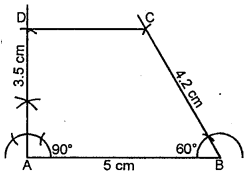
Question 3.
Construct a quadrilateral ABCD in which AB 3·5 cm, BC = 5 cm, CD = 5·6 cm, DA = 4 cm and BD = 5·4 cm
Solution:
Steps of construction :
(i) Draw AB = 3·5 cm.
(ii) With A as centre and radius = 4 cm,
draw an arc and with B as centre and radius = 5·4 cm
draw an arc to meet the previous arc at D. Join AD and BD.
(iii) With B as centre and radius = 5 cm, draw an arc.
With D as centre and radius = 5·6 cm,
draw an arc to meet the previous arc at C.
(iv) Join BC and CD, then ABCD is the required quadrilateral.

Question 4.
Construct a quadrilateral PQRS in which PQ = 3 cm, QR = 2·5 cm, PS = 3·5 cm, PR = 4 cm and QS = 5 cm.
Solution:
Steps of construction :
(i) Draw a line PQ = 3 cm.
(ii) With P as centre and 3.5 cm as radius,
draw an arc and with Q as centre and 5 cm as radius,
draw an arc to meet the previous arc at S.
(iii) Join PS and QS.
(iv) With Q as centre and radius = 2.5 cm,
draw an arc and with P as centre and radius = 4 cm,
draw an arc to meet the previous arc at R.
(v) Join PR and QR.
(vi) Join RS, then PQRS is the required quadrilateral.

Question 5.
Construct a quadrilateral ABCD given that BC = 6 cm, CD = 4 cm, ∠B = 45°, ∠C = 90° and ∠D = 120°.
Solution:
Steps of construction :
(i) Draw BC = 6 cm.
(ii) At B, construct ∠CBP = 45°.
(iii) At C, construct ∠BCQ = 90°
(iv) From CQ, cut off CD = 4 cm.
(v) At D, construct ∠CDR = 120°.
(vi) Let BP and DR meet at A.
Then ABCD is the required quadrilateral.
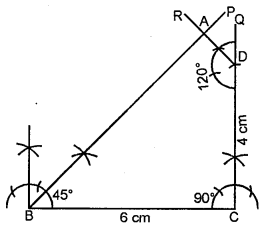
Question 6.
Construct a parallelogram ABCD in which AB = 5.2 cm, AC = 6.5 cm and BD = 7.8 cm.
Solution:
Steps of construction :
(i) Draw a line segment AB = 5.2 cm.
(ii) With centre A and radius \(\frac{6.5}{2}\) cm = 3.25 cm
and with centre B and radius \(\frac{7.2}{2}\) =3.6 cm,
draw arcs intersecting each other at O.
(iii) Join AO and BO and produce them such that OC = AO and OD = BO.
(iv) Join DA, DC, CB.
ABCD is the required parallelogram.

Question 7.
Construct a parallelogram ABCD in which diagonal AC = 4 cm, diagonal BD = 6 cm and angle between diagonals is 75°.
Solution:
Steps of construction :
(i) Draw AO = \(\frac{1}{2}\) AC = \(\frac{1}{2}\) (4 cm) = 2 cm and produce AO to C
such that OC = OA.
(ii) At O, construct ∠COP = 75°.
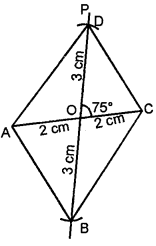
(iii) From OP, cut OD = \(\frac{1}{2}\) BD = \(\frac{1}{2}\)(6 cm) = 3 cm.
produce OD to B such that OB = OD.
(iv) Join AB, BC, CD and DA, then ABCD is the required parallelogram.
Question 8.
Construct a rectangle PQRS such that PQ = 3·5 cm and ∠RPS = 75°.
Solution:
Steps of construction :
(i) Draw PQ = 3·5 cm.
(ii) At Q, draw ∠PQT = 90°.
(iii) At P, draw angle of 15° which meet QT at R.
(iv) With R as centre and PQ as radius draw an arc.
(v) With P as centre and QR as radius cut the previous arc at S.
Join PS and RS. Then PQRS is the required rectangle.
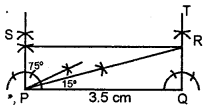
Question 9.
Construct a rectangle whose one diagonal is 6-8 cm and an angle between two diagonals is 105°.
Solution:
Steps of construction :
(i) Draw AO = \(\frac{1}{2}\) AC = \(\frac{1}{2}\) (6.8 cm) = 3·4 cm and produce AO to C
such that OC = OA = 3·4 cm.
(ii) At O, construct ∠COP = 105°.
(iii) From’OP, cut off OD = \(\frac{1}{2}\) AC = \(\frac{1}{2}\) × 6·8 = 3·4 cm.
[Because both the diagonals of rectangle are equal]
(iv) Produce OD to B such that OB = OD = 3·4 cm.
(v) Join AB, BC, CD and DA. Then ABCD is the required rectangle.
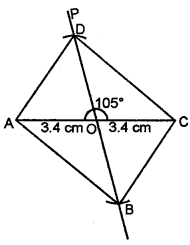
Question 10.
Construct a rhombus BEST such that BE = 4.5 cm, ET = 6 cm.
Solution:
Steps of construction :
(i) Draw a line segment BE = 4.5 cm.
(ii) With centre B and radius 4.5 cm
and with centre E and with radius 6 cm
draw arcs intersecting each other at T.
(iii) Join TB and TE.
(iv) Again with centres E and T,
and radius 4.5 cm from both points,
draw arcs intersecting each other at S.
(v) Join ST and SE.
BEST is the required rhombus.
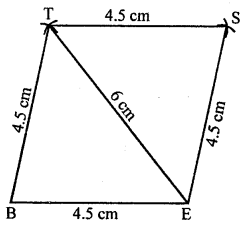
Question 11.
Construct a rhombus whose diagonals are 7 cm and 5·3 cm.
Solution:
Steps of construction :
(i) Draw AC = 7 cm.
(ii) Draw ⊥ bisector PQ of AC to meet it at O.
(iii) From POQ, cut off OB and OD such that OB = OD = \(\frac{1}{2}\) BD = \(\frac{5.3}{2}\) = 2·65 cm
(iv) Join AB, BC, CD and DA. Then ABCD is the required rhombus.

Question 12.
Construct a square whose one diagonal is 5·8 cm.
Solution:
Steps of construction :
(i) Draw AC 5·8 cm.
(ii) Draw perpendicular bisector PQ of AC to meet it at O.
(iii) From POQ, cut off OB = OD such that OB = OD = \(\frac{1}{2}\)AC = \(\frac{1}{2}\) × 5·8 = 2·9 cm.
(iv) Join AB, BC, CD and DA. Then ABCD is the required square.
